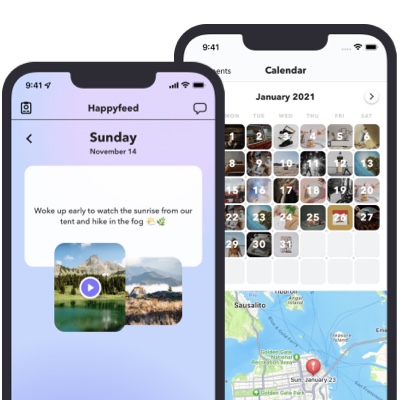What is a Gratitude Journal?
Published September 6, 2018

Gratitude journaling is the habit of recording and reflecting on things (typically three) that you are grateful for on a regular basis. In essence, you are rewiring your brain to focus more on the positive aspects of your life and build up resilience against negative situations. Keeping a gratitude journal is a popular practice in positive psychology - the scientific study of happiness. It’s commonly also referred to as “counting your blessings” or “three good things.”
Gratitude journals come in all shapes and sizes.
The physical format of your gratitude journal is not nearly as important as how you use it. Some people prefer to create a bullet-style journal with short entries, while others enjoy diving into their thoughts with longer posts. The goal of this article is to provide some tips, tricks, and research to help you find the best way to make it an effective habit for you.
What are the benefits of gratitude?
Recent research in positive psychology suggests that practicing gratitude may increase overall feelings of happiness and reduce depressive symptoms. One of the most commonly cited research papers relating to gratitude journals is by Robert A. Emmons and Michael E. McCullough1. They ran three studies in which participants were instructed to record daily experiences:
“The gratitude-outlook groups exhibited heightened well-being across several, though not all, of the outcome measures across the 3 studies, relative to the comparison groups. The effect on positive affect appeared to be the most robust finding.”
Though you may start feeling the effects of keeping your gratitude journal early on, some research suggests that the benefits only become significant after a month of journaling and increase over time2. An initial happy “boost” may relate more to the excitement of starting a new habit; learning to focus on the good things requires a bit more time. Try to be patient with the process.
Tips for keeping a gratitude journal
Gratitude seems like a simple enough concept, right? You can probably think of a few things right now: your family, your friends, health… that’s three, easy!
- Enjoy the little things - Specifics are what make your gratitude journal unique and full of little surprises. Writing “amazing friends” may miss most of the emotion compared to “Amy stopped by this afternoon with iced tea and scones.”
- Avoid repetition - Ok, your significant other really is amazing, but you don’t want their name to be the only thing in your journal. Mix it up with different domains of life, e.g. work, relationships, or health. This can keep the practice “fresh” and extend the effectiveness of gratitude journaling3.
- Mention specific people and places - Along the lines of avoiding repetition, citing specific people and places will help prevent your posts from feeling stale. You’ll also be learning more about who and what affects your happiness.
- Don’t sweat the bad days - Everyone has bad, awful days where nothing went your way. Gratitude journaling can be most important on the most difficult days - try to push aside the negativity and go simple (“my mom” or “tacos at lunch”).
- Flex your “writer” muscles - Have some fun with your posts! Throw in some extra adjectives, try to describe the way the fall air tasted, and explore details you normally wouldn’t. It’s rare to find opportunities to write, and what could be better than your private journal?
- Make it a habit - It’s generally suggested that you try writing in a gratitude journal at night before bed. Setting a reminder or pairing it with another habit (brushing your teeth, meditating) will make it easier to be consistent.
- Mention surprises - Not every day will have these, but reflecting on surprises is a useful way to avoid repetition and really savor your best days.
Apps provide all sorts of benefits from photo uploading to fun ways to explore past memories
Looking for an easy way to journal?
Happyfeed is a simple gratitude journaling app available for iPhone and Android. We make it easy and fun to start your new habit.
Try it freeDigging deeper: Gratitude journal ideas and prompts
Effort and intentionality are the main ingredients to starting a successful gratitude journaling habit. As soon as your journal becomes another autopilot task (like checking your social newsfeed) it starts to lose its effectiveness.
- Savor those feelings - Some moments stand out from all the others. When you’re lucky enough to have those emotions, really really savor them. Literally close your eyes and take in all the smells, sounds, and thoughts. Learn to do this often and you might discover you’re luckier than you thought.
- Thank someone - Go the extra mile and actually reach out and tell someone how much you appreciate them. Send them a “thank you” note or just wait until their birthday and send a real card. Remember the last time you received a letter? It’s an absolute delight and something neither of you will forget.
- Learn from your habits - Remember how I said to avoid too much repetition in your gratitude journal? Recognizing patterns and themes can help you learn more about your happy triggers. For example, I tend to love days where I wake early and work on something I love. By doing this more often, I can actually affect my happiness.
If you are feeling stuck or need an extra nudge, try one of these gratitude journal prompts:
- Who is someone that consistently makes your life easier?
- How are the seasons or weather affecting your mood today?
- Has anything been going particularly well at work? Why?
- Did you catch yourself smiling at anything today?
- What trips are you looking forward to? What excites you?
- What habits or routines bring you joy? What was different today?
- Any experiences with nature today? How did it affect you?
Comparing gratitude notebooks and journaling apps
If you are anything like me, you probably love the feeling of pen and paper. I grew up taking notes in journals, notebooks, and countless loose-leaf sheets of paper. There’s something special about the way you can express thoughts on a blank piece of paper. Even the doodles you sketch in the margins can trigger memories or remind you of details you’d otherwise forget.
So, why would you ever want to ditch your notebook for a gratitude journal app?
First off, I don’t recommend completely replacing your journaling habits with an app on your phone or laptop. I like to think of the app (Happyfeed in this case) as a supplement to journaling. You might not be able to doodle in your app, but I’ll bet your old journals don’t have a camera, internet connection, or GPS.
Benefits of using an app:
- Easy to add photos - If a picture is worth a thousand words, that’ll save you a lot of writing.
- Location tracking - It’s fun to reflect on where you’ve been, what places make you happiest, and where you might be heading.
- Cloud backup - I’ve broken more phones and lost more journals than I’d like to admit. It’s nice to know your memories will last as long as you want them.
- Reminders - Push notifications on your phone make it easy to remind yourself to enter moments each day.
- Search - Maybe you wanted to remember the name of that coffee shop you loved in Prague? Databases provide a unique opportunity to find patterns and resurface old information.
Summary
Starting a gratitude journal is a very personal decision and you should create yours in the way that best suits you. This article is based on research and readings but heavily biased by my time keeping a gratitude journal (nearly 1300 completed days as of posting this). As you grow your habit, you’ll figure out what works for you and what doesn’t. Taking the effort to learn what makes you happy and how to best capture those feelings will benefit you in more ways than you might expect. I hope this article serves as a helpful framework for getting started or just staying on track.
If you’d like to chat about gratitude or share how journaling has helped you, please send me a message - I’d love to hear from you.
Inspired by positive psychology research
Free Gratitude Journal App
Happyfeed is a simple gratitude journal available on iOS and Android. Record three good things each day with photos to start focusing more on the bright side.
Learn moreReferences:
1: Emmons RA, McCullough ME. (2003). Counting blessings versus burdens: an experimental investigation of gratitude and subject wellbeing in daily life. J. Personal. Soc. Psychol. Link
2: Seligman, M. E. P., Steen, T. A., Park, N., & Peterson, C. (2005). Positive psychology progress: Empirical validation of interventions. American Psychologist, 60, 410-421. Link
3: Lyubomirsky, S., Sheldon, K. M., & Schkade, D. (2005). Pursuing happiness: The architecture of sustainable change. Review of General Psychology, 9, 111-131. Link


